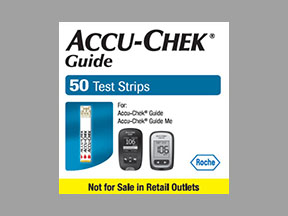
Accu-chek Guide Test Coupons & Savings Card – Discount Prices from $41.76
My prescription
Edit
1, Accu-chek Guide Test (100 Strips)
Select pharmacy

Albertsons
$41.76
COUPON PRICE
Walgreens
$41.76
COUPON PRICEAccu-chek Guide Test savings card
Show this card to your pharmacist
Albertsons
$41.76
BIN
ID
PCN
GRP
011867
LH3B7DC83B
HT
LABH001
Powered by
Price history for Accu-chek Guide Test
100 Strips, 1nan
Average retail price for Accu-chek Guide Test
Average SaveHealth price for Accu-chek Guide Test
Our price history data is based on aggregated prescription data collected from participating pharmacies in America. Our prescription data updates daily to reflect the latest price changes. If you notice a missing data point, it means there wasn't sufficient data available to generate a monetary value for that date.
*Retail prices are based on pharmacy claims data, and may not be accurate when we don't have enough claims.
Accu-chek Guide Test dosage forms
Dosage Quantity Price from Per unit 1nan 100 Strips $43.52 $0.43 1nan 50 Strips $22.76 $0.46
| Dosage | Quantity | Price from | Per unit |
|---|---|---|---|
| 1nan | 100 Strips | $43.52 | $0.43 |
| 1nan | 50 Strips | $22.76 | $0.46 |
Accu-chek Guide Test Warnings
Proper handling and storage of Accu-Chek Guide test strips are essential to ensure accurate blood glucose readings and to minimize potential risks. Here are key safety considerations:
Storage and Handling:
Keep the vial sealed: Always store unused test strips in their original container with the cap tightly closed. This practice protects the strips from exposure to humidity and contaminants, which can compromise their accuracy.
Avoid using expired strips: Using test strips past their expiration date can lead to inaccurate results. The expiration date is printed on each vial; ensure you check it before use.
Proper handling: When removing a test strip from the vial, ensure your hands are clean and dry. Avoid bending the strip or contaminating it with dirt.
Potential Risks:
Inaccurate readings: Improper storage, such as leaving the vial open or exposing strips to high humidity, can damage the strips and result in false readings. For instance, using strips from an open vial may lead to positively biased or falsely elevated results.
Device malfunctions: There have been reports of significant discrepancies between readings from Accu-Chek Guide test strips and laboratory devices. Such inconsistencies can lead to inappropriate therapy decisions.
Recommendations:
Regular control tests: Perform control tests periodically to verify that your meter and test strips are functioning correctly. This is especially important if you suspect the strips have been exposed to unfavorable conditions.
Consult healthcare professionals: If you receive unexpected or inconsistent blood glucose readings, consult with your healthcare provider to determine the best course of action.
By adhering to these guidelines, you can help ensure the reliability of your blood glucose monitoring and reduce potential risks associated with inaccurate readings.
Accu-chek Guide Test Side Effects
Accu-Chek Guide test strips are designed to help individuals with diabetes monitor their blood glucose levels accurately. When used correctly, these test strips are generally safe and reliable. However, there have been reports of discrepancies in blood glucose readings when using these strips. For instance, some users have reported receiving significantly different results within a short time frame, such as 186 mg/dL on one device and 97 mg/dL on another. (fda.report) Such inconsistencies can lead to confusion and may affect diabetes management decisions. To ensure accurate readings, it's essential to follow the manufacturer's instructions carefully. This includes using the test strips before their expiration date, storing them properly, and handling them with clean, dry hands. If you notice unexpected or inconsistent results, it's advisable to perform a control test using the meter's specific control solution. This helps verify that the system is functioning correctly. If discrepancies persist, consult with your healthcare provider to discuss alternative testing methods or devices.
Accu-chek Guide Test Interactions
Using the SaveHealth discount card, what is the price of Accu-chek Guide Test without insurance?
Using the SaveHealth discount card, the price of Accu-chek Guide Test without insurance is $41.76.
What is the price of Accu-chek Guide Test at Walgreens?
The price of Accu-chek Guide Test at Walgreens is $41.76.
